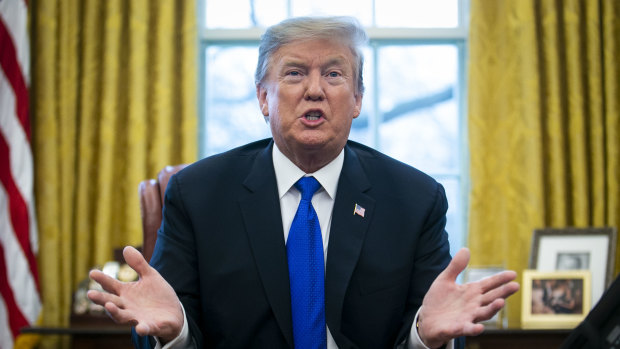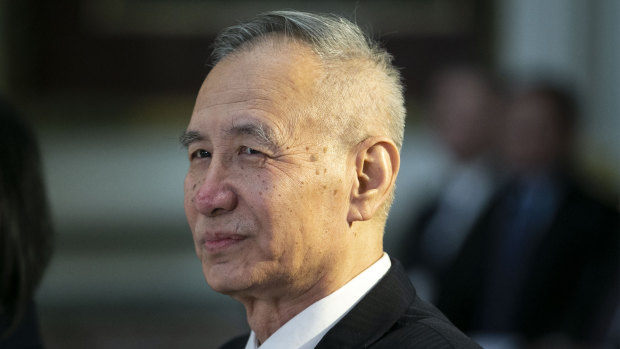This was published 6 years ago
Opinion
Trump the 'Tariff Man' returns to threaten markets, risking full scale trade war
Stephen Bartholomeusz
Senior business columnistThe return of the Tariff Man and his threats to escalate the trade conflict with China even as it appeared to be close to a resolution threatens, at face value, to undermine markets and growth in the global economy.
It needs qualification because who, other than Donald Trump, could possibly know why he chose, at such a delicate moment in trade negotiations, to canvass raising the rate on $US200 billion of China’s exports to the US from 10 per cent to 25 per cent, adding another $US325 billion of extra goods to the $US250 billion already attracting the duties.

Trump's tariff threats: A negotiating tactic or posturing for his base?Credit: Bloomberg
The threat may be a (very) crude negotiating tactic from the great deal-maker, aimed at coercing the Chinese into making concessions they otherwise might not proffer as the final round of negotiations on a trade deal gets underway in Washington this week.
Or, given that the Chinese appear to have decided that there are some key US demands that are non-negotiable, perhaps it is simply a way of Trump signalling his toughness so that he can characterise a less-than-optimal deal (from the administration’s perspective) as a triumph.
A concern that Trump might be serious saw the Australian sharemarket open weaker. Asian markets also tumbled on Monday as investors digested the news, with the Hang Seng down 2.8 per cent and the Shanghai Composite down 3.7 per cent.
The US futures markets are signalling a sell-off when its equities markets open overnight, with contracts on the S&P 500 and Dow Jones indices foreshadowing a 2 per cent fall.
The difficulty in trying to determine whether the Trump tweets on Sunday are just bluff and bluster or something with more substance is that, once again, the US president has betrayed an unsettling lack of understanding of the tariffs he threaten to impose.
"These payments (the tariffs) are partially responsible for our great economic results," he said. He’s previously talked about the billions of dollars the Chinese have been paying into the US Treasury’s coffers.
In fact it is the US importers who pay the tariffs, raising costs for US companies and consumers. An analysis of the trade confrontation by the New York Federal Reserve and Princeton and Columbia universities estimated that the existing tariffs were costing US consumers $US1.4 billion ($2 billion) a month, or an annualised $US16.8 billion.
Trump’s economic illiteracy means it is quite feasible he doesn’t understand that the threat of raising the existing tariffs – from Friday – and adding another tariff on a further $US325 billion of China’s exports "shortly" would be mutually destructive.
It would really hurt China but it would also have an adverse impact on the US and the rest of the world, especially Australia.
If he saw it as a negotiating tactic, then it was an unsophisticated and unnecessary one.
The threat of an increase in the rate of the existing tariffs and the extension of their coverage to the rest of China’s exports to the US has been implicit ever since the US initiated the conflict. It is what brought China to the negotiating table.
It wasn’t necessary or useful to make that threat explicit just as China’s Vice-Premier, Liu He and more than 100 Chinese officials arrive in Washington for the final round of talks with their US counterparts. In a dramatic move late on Monday, China said it was considering delaying the talks.

Chinese Vice-Premier Liu is about to arrive in Washington with more than 100 Chinese officials for the final round of trade negotiations.Credit: Bloomberg
It has been apparent for some time that, while China is prepared to make some concessions to the US demands, there are some non-negotiables.
It is prepared to buy more US agricultural products and LNG, open up some markets and agree not to force, directly or indirectly, US companies to provide access to their intellectual property. It isn’t however, prepared to abandon its centrally-directed industry policies and the state subsidies that are inherent in them.
Another major sticking point has been the US demand that the existing tariffs remain in place until China has complied with the terms of the deal, even once they have been scaled back, and that the US retain the right to unilaterally re-impose them for a perceived breach without China being able to retaliate.
Accepting such a one-sided enforcement mechanism would be humiliating for the Chinese and their president, Xi Jinping, with potential domestic political implications.
The best hope for the Chinese is that the weekend’s tweets were just Trump’s usual bluff and bluster to show how tough a negotiator he is; window-dressing for his base ahead of a deal that won’t actually live up to his promises.
That would be an outcome similar to Trump’s renegotiation of the North American Free Trade Agreement, or NAFTA.
That deal, which Republicans in Congress are threating to block unless Trump drops his cherished tariffs on steel and aluminium imports, essentially rebadged NAFTA, after some minor tinkering, as the United States-Mexico-Canada Agreement (USMCA).
If, however, Trump is serious and China isn’t prepared to kowtow to his threats and concede on all the major issues the administration regards as important, we’ll have a full-scale trade war between the US and China, one where China’s ability to respond is limited by the reality that it imports a lot less from the US - $US120 billion last year – than the $US540 billion of US imports from China.